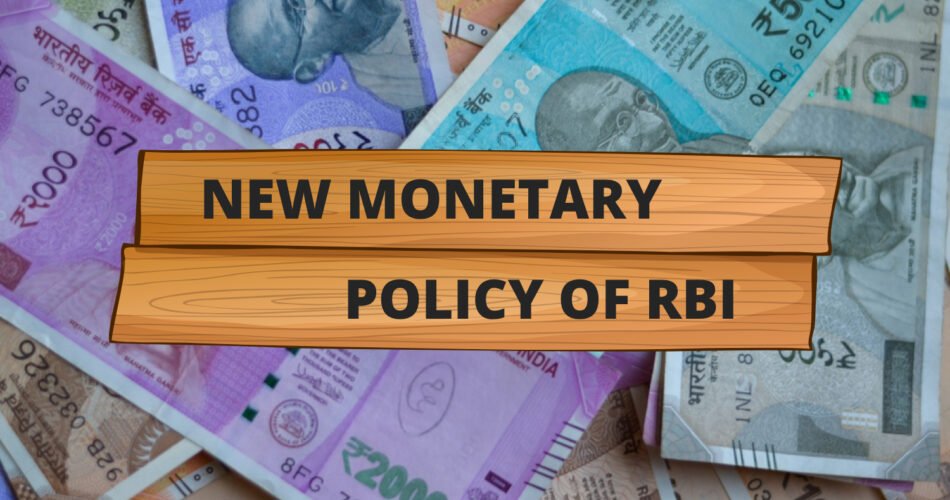New Monetary Policy of RBI
The new monetary policy of RBI was announced to address the rising credit needs amid the growing economy, with a projected GDP growth rate of 8.7 percent for 2021-22. The anticipated inflation rate for the same period, based on consumer prices, was 5.5 percent per annum. The primary objectives of the new monetary policy encompass price stability, financial well-being, and ensuring sufficient credit for development. The key measures of the new monetary policy include:
Read More: Monetary Policy of India

New Monetary Policy of RBI
Measures of the New Monetary Policy
Measures of the New Monetary Policy in India
Explore the dynamic measures introduced in the new monetary policy to navigate India’s economic landscape:
Measures of the New Monetary Policy
- Reduced Cash Reserve Ratio (CRR): The RBI has strategically decreased the Cash Reserve Ratio to 4.50 percent, aiming to boost liquidity and support economic growth.
- Bank Rate Adjustment: The Monetary Policy 2021-22 sets the Bank Rate at 5.15 percent, playing a pivotal role as the active rate in shaping financial dynamics.
- Repo and Reverse Repo Rate Adjustments: With the Repo Rate at 4.90 percent and Reverse Repo Rate at 3.35 percent, the Reserve Bank continues to fine-tune these rates to bolster liquidity in the economy.
- Marginal Standing Facility (MSF): Introduced in 2011-12, MSF allows banks to borrow up to 1 percent of their liabilities with an interest rate 0.25 percent higher than the repo rate.
- Statutory Liquidity Ratio (SLR) for Regional Rural Banks: Regional Rural Banks can now retain their SLR deposits with themselves, capped at 18 percent as of June 2022.
- Interest Rate Flexibility for Banks: Banks gain flexibility in setting interest rates within defined limits and can reset deposit interest rates every six months, ensuring responsiveness to market conditions.
- Transparency Initiatives: Banks are mandated to disclose deposit interest rates for various maturities, fostering transparency. Information on maximum and minimum borrower interest rates is also accessible to the public.
- Low-Interest Rate on Export Credit: The new policy targets reducing the highest interest rates on export credit, promoting transparency with disclosed interest rate ranges for exporters.
- Abolition of Minimum Lending Rate for Cooperative Banks: Cooperative banks now have autonomy in setting lending rates, enhancing competitiveness and flexibility.
- Liberalization of Investment Norms: Banks are now permitted to invest fixed deposits in Long-Term Fixed Income Instruments, contributing to a streamlined investment landscape.
- Eased Borrowings from Overseas Markets: Banks can now borrow up to 25 percent of free funds from foreign markets, promoting affordability and potentially reducing funding costs.
- Priority Sector Lending Relaxations: Several relaxations in priority sector lending include increased credit limits for crop-secured loans, higher borrowing limits for small-scale industries, and encouragement for Kisan Credit Cards.
- Lending/Borrowings in Call Money Market: Banks can engage in lending in the call money market, capped at 25 percent of their capital, facilitating short-term liquidity management.
- Introduction of Base Rate System: The new policy introduces the Base Rate System, setting the minimum interest rate banks can charge on loans, enhancing interest rate transparency.
- Empowerment of Women in Banking: Reserved credit share for women and Self-Help Groups (SHGs) aims at fostering financial inclusion and empowerment.
- Expansion of ATMs and Core Banking Solutions (CBS): The proliferation of ATMs, totaling 213,575 by March 2022, and widespread adoption of Core Banking Solutions enhance banking accessibility and services.
- Financial Inclusion Initiatives: Initiatives like ‘Swabhiman’ and Pradhan Mantri Jan Dhan Yojana work towards providing banking services in rural areas without branches.
- Emphasis on Financial Education: Banks are directed to focus on financial education, providing information in local languages to diverse demographics.
- Credit Information Companies: Registered credit information companies assist banks in assessing credit capacity, contributing to the reduction of non-performing assets.
- Certificate of Deposits (CDs): Issued by banks, CDs in multiples of Rs. lakh with various maturity periods provide an alternative investment option.
- Interest on Savings Bank Accounts: Banks have the autonomy to set interest rates on savings accounts, benefitting depositors with potentially higher rates.
- Prepaid Cards Issuance: Banks are directed to issue prepaid cards, facilitating seamless market transactions and bill settlements for users.
Measures of the New Monetary Policy
Explore these innovative measures shaping India’s monetary policy landscape. For more in-depth insights into financial strategies and economic policies, delve into related articles on monetary policy evolution and economic development in India.
Measures of the New Monetary Policy
Read More: Economic Reforms in India
Measures of the New Monetary Policy
Read More: Meaning and Features of Underdeveloped Economy
Conclusion
The new monetary policy unveiled by the RBI reflects a strategic response to the evolving economic landscape. With a keen focus on factors like price stability, financial conditions, and developmental credit, the policy introduces a range of measures. From adjustments in cash reserve ratios to interest rate flexibility, the RBI aims to strike a balance that fosters economic growth while ensuring stability. Moreover, the emphasis on transparency, credit planning, and coordination between monetary and fiscal policies underscores a commitment to a holistic and adaptive approach. As the RBI addresses challenges and embraces innovations, this new policy sets a forward-looking tone for monetary management, aiming to propel the economy into a trajectory of sustained and inclusive growth.

